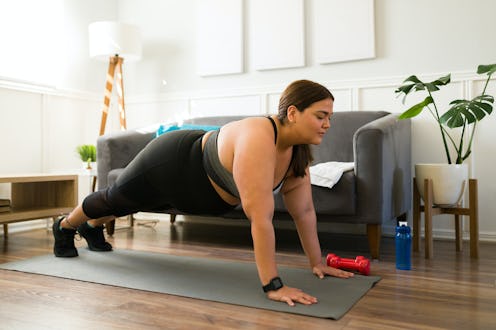Fitness
The “Dragon Walk” Exercise Is What Nightmares Are Made Of
Here's how to crawl like a lizard for stronger abs.

While the idea of crawling across the gym floor might not immediately pique your interest, there are countless reasons to try your hand at the low and slow dragon walk exercise, especially if you’re looking for new and fresh ways to work your core.
This ab move looks nothing like a crunch. To do a dragon walk, simply attempt your best impression of a lizard: Like a crawling reptile, this moving plank-push-up mashup has you stay low to the ground while you use a knee-to-elbow motion to move forward, says Becka Nieder, a trainer and owner of Becka’s Bootcamp. For another animal-related visual, think about a bear crawl but with a little more bend.
“The dragon walk exercise targets your entire core, from your rectus abdominis and obliques to your gluteal complex and erector spinae,” Nieder tells Bustle. It’s a full-body compound strength training move that can improve your balance and overall stability, she adds, which means it totally counts as a functional exercise that can help you feel stronger in everyday life (making it worth the challenge).
The slinky motion of the exercise challenges your abs, and it also brings mobility into your chest, hips, and spine to increase your range of motion, says certified personal trainer Matt Scarfo, CPT-OPT, CES, PES, FNS. Nieder adds that it’s also a good stretch for your hamstrings and pectoral muscles, too. It may look and feel like the hybrid workout move of your wildest nightmares, but it’ll do your body good — here’s how to give it a try, if you so dare.
How To Do The Dragon Walk Exercise
Here, Scarfo explains how to do a dragon walk using good form. (Note: This exercise has a lot of moving parts, so don’t worry if it takes a few attempts to catch on.)
- Start in a high plank or push-up position.
- Reach your left hand forward.
- At the same time, bend your right side to bring your right knee up to meet your right elbow.
- Plant your right foot.
- Push off with your left leg to begin moving forward.
- Bend your left side to bring your left knee to meet your left elbow.
- Plant your left foot.
- Reach forward with your right hand.
- Push off with your right leg.
- Bring your right knee to your right elbow.
- Continue this forward motion.
How To Modify A Dragon Walk
Nieder recommends setting a timer for 45 to 60 seconds as you dragon walk with good form across the room. When the timer goes off, take a 10 to 20-second break, then repeat this work/rest interval for six cycles. To make this move a little easier, walk for a shorter amount of time.
You can also perform a similar motion without crawling forward, which is great if you’re short on space or want to take a little extra pressure off your core. Scarfo says you can also modify the dragon walk by doing an elevated walk against a wall or bench. Instead of holding a push-up position on the floor, place your hands against a wall or bench and practice lifting one leg and touching it to your elbow, then lowering it and touching your other leg to your other elbow, he says.
“You can also do bear crawls, which require less core strength because you keep your legs straight,” Scarfo explains. “This helps build your shoulders, upper chest, and triceps so you’re prepared for the lower posture.”
Mistakes To Avoid
The key to a good dragon walk is to maintain a flat back. “If your chest or hips sag, you can put pressure on your shoulders or spine, increasing your risk for injury,” Scarfo says. “Try to keep the movement controlled so that you’re not swaying in a way that can put pressure on the spine.”
Another common mistake is taking a step that’s too big with your hand and foot each round, Nieder says. Since this will cause your hips to come out of alignment, try to take smaller steps as you slither forward. That way you’ll dragon walk in a slow, controlled way, and make the most of the hellish-but-worth-it move. Good luck.
Studies referenced:
Cortell-Tormo, JM. 2018. Effects of functional resistance training on fitness and quality of life in females with chronic nonspecific low-back pain. J Back Musculoskelet Rehabil. doi: 10.3233/BMR-169684.
Sources:
Becka Nieder, trainer, owner of Becka’s Bootcamp
Matt Scarfo, CPT-OPT, CES, PES, FNS, NASM-certified personal trainer
This article was originally published on